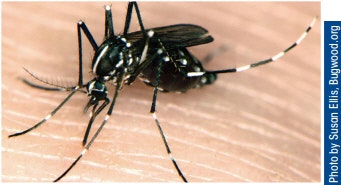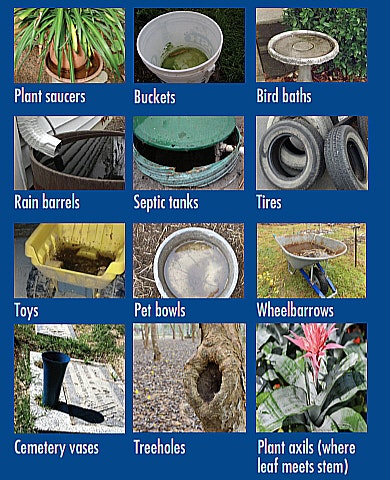Invasive Mosquito Species
Aedes aegypti and Aedes albopictus - Invasive Mosquito Species Capable of Transmitting Viruses that Cause Serious Diseases
Para ver esta página en español haga clic aquí
Commonly referred to as the Yellow Fever mosquito, the Aedes aegypti mosquito has a worldwide distribution in tropical and subtropical areas. In August 2022, August 2024, September 2024, and May 2025, Aedes aegypti were found in Contra Costa County.

• Aedes aegypti is a small, dark mosquito with a white violin-shaped marking on its back and banded legs.
• Aedes aegypti has the ability to transmit the viruses that cause dengue fever, chikungunya, yellow fever, and Zika.
Aedes albopictus, commonly referred to as the Asian Tiger mosquito, is native to Asia, was reintroduced to Los Angeles County in 2011, and has spread throughout neighboring areas of Southern California. This mosquito has not been identified in Contra Costa County.
• Aedes albopictus is a small, dark mosquito with a white stripe on its back and banded legs.
• This mosquito not only has the ability to transmit the viruses that cause dengue fever, chikungunya, and yellow fever viruses, but it has also been found infected in nature with the following viruses: West Nile, Eastern equine encephalitis, and Japanese encephalitis. It can also transmit dog heartworm parasites.
Common Characteristics of Aedes aegypti and Aedes albopictus Mosquitoes

• These mosquitoes are aggressive biters. They will bite people throughout the day and can bite people while outdoors or indoors.
• They are approximately 1/8 – 1/4 of an inch in size.
•Their peak feeding times are during the early morning and late afternoon; however, they will bite anytime during the day.
• The entire aquatic cycle (i.e. from egg to adult) can occur in as little as 7–9 days. The life span for adult mosquitoes is around three weeks.
• They have a short flight range, so egg laying sites are likely to be close to where the mosquitoes are found.
• These mosquitoes lay individual eggs, often on dry surfaces. The eggs are resistant to drying out for six months or longer.
• During winter, these mosquitoes can survive in the egg stage. When the eggs are covered with water in warm weather, the mosquitoes continue developing into larvae.
Common Places Where These Invasive Mosquito Species Lay Their Eggs
These mosquitoes are commonly found in urban, suburban, and rural areas, as well as the edges of forested areas. Backyards are the #1 source for mosquito production. Anything that can hold water for more than a few days has the ability to produce mosquitoes. Common sources include:

Help Us Detect Invasive Mosquito Species
- Dump out any amount of standing water at least once a week to prevent mosquitoes.
- Always report mosquito issues to the Contra Costa Mosquito and Vector Control District by calling us at (925) 685-9301 or by reporting mosquito issues online.
A local species, Aedes sierrensis, also known as the Western tree hole mosquito, is similar in size and also bites people during the day, but it lacks the white stripe on the back and is more drab in coloration. It can be mistaken for the Asian tiger mosquito.
This mosquito is usually prominent in areas with older trees and is active from April through July. Western tree hole mosquitoes are capable of transmitting the parasites that cause dog heartworm disease.
Western tree hole mosquito
Additional Resources
Invasive Mosquito Species (brochure)A fact sheet provided by the California Department of Public Health.
A question and answer sheet provided by the California Department of Public Health.
(Un)Wanted: Aedes aegypti and Aedes albopictus Mosquitoes
Information on these invasive mosquitoes and Dengue courtesy the Centers for Disease Control
Courtesy of the California Department of Public Health.
Yellow Fever: Causes and How it Spreads
Information courtesy of the Centers for Disease Control
Hoja Informativa sobre Aedes aegypti (Mosquito de la Fiebre Amarilla)
Información en español.
